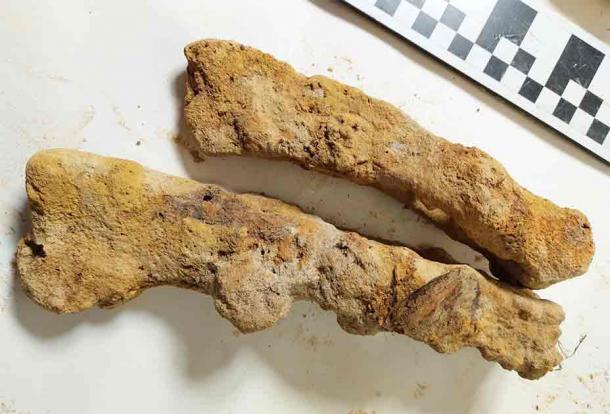
Weapons of Germanic Tribes from Roman Era Discovered in Poland
In the now serene landscapes of Hrubieszów, on the eastern border of Poland, a remarkable discovery has recently emerged, casting new light on the region's ancient history. The find of likely Germanic tribal weapons, a result of Mateusz Filipowicz's accidental encounter, has unveiled a window into the battles of the late Roman era.
Iron spearheads, two battle axes and a wood-cutting axe are among the ancient items discovered near Hrubieszów by treasure hunters. The weapons most likely come from Roman times and were used by warriors from barbarian tribes.
The Lublin Provincial Conservator of Monuments announced the discovery on social media.
Unveiling History's Layers
According to the conservator, treasure hunters searching in the State Forests near Hrubieszów found a cluster of several iron artifacts. 'At first, due to the very strong corrosion covering the metal, additionally mixed with sand and mud, it was difficult to determine what these objects were,’ he says.
As Filipowicz traversed the degraded forest terrains, churned up by use of heavy machinery and the rigors of nature, he stumbled upon an unusual sight: dozens of iron relics, barely indiscernible, as they were obscured by corrosion and camouflaged by the earth.
Following the unexpected discovery, the objects were extracted and transported for analysis. The Hrubieszów Museum became the new home for these historical remnants, where archaeologists Bartłomiej Bartecki and Anna Hyrchała undertook the task of unraveling their secrets.
- Rethinking Barbarians: Were They Really Savages?
- The History of the Piast Dynasty, the First Rulers of Poland

Spearheads from the Hrubieszów find site in Poland. (B. Bartecki /©Lublin Provincial Conservator of Monuments)
A Glimpse into a Forgotten Arsenal
The collection, though encrusted with the ravages of time, was slowly revealed. It comprised:
- Nine iron spearheads, their lengths ranging from 25.5 to 34.5 cm (10 to 13.5 inches), with leaf-shaped blades ranging between 5 to 6.5 cm (2 to 2.6 inches) wide.
- Two iron battle axes, one measuring 23.5 cm (9.25 in) in length and the other, slightly smaller, at 19 cm (7.5 in).
- An ambiguous iron artifact, possibly an axe, 17 cm (6.7 in) in length.
- Additional objects of uncertain function, potentially a shield holder, and unidentified iron tools, awaiting clarity from further study.

Two battle ax heads. (B. Bartecki /©Lublin Provincial Conservator of Monuments)
The assemblage of artifacts raises intriguing questions about its origins and the hands that once wielded these weapons.
'First of all, we are most likely dealing with weapons used by barbarian tribes during the times of the Roman Empire. Perhaps they were used by warriors who belonged to the so-called Przeworsk culture (1st century BC - 2nd/3rd century AD), identified by archaeologists as members of the Vandal tribe, or the communities from the Gothic cultures (2nd/3rd century AD - 5th century AD),’ the conservator said in the announcement on Facebook.
- The Hidden Story of Poland: What Happened to the Forgotten Kingdom of Lechia?
- Barbarians versus Romans: Violence and Urban Life in Late Antiquity
Beyond a Simple Burial: A Story of Secrecy and Survival
The circumstances surrounding the deposit of these weapons exclude traditional burial practices, which were not common to the tribes of the area. Instead, they suggest deliberate concealment, a testament to the strategic adaptations of ancient peoples to their environment.
Promptly reported to the Zamojska Delegation of the Provincial Office for the Protection of Monuments and the Lublin Provincial Conservator, the find has sparked excitement within the archaeological community.
“Who actually decided to throw in the river, swamp this set? The Vandals? Goths? Let's wait for the final answer, but this is undoubtedly one of the most interesting discoveries of the recent years.” said the Lublin conservator statement.
The Museum Stanisława Staszica in Hrubieszów now safeguards these relics, which are undergoing preservation.

A collection of spearheads found at the site. (B. Bartecki /©Lublin Provincial Conservator of Monuments)
A New Chapter in Gothic Research?
This discovery has rekindled discussions on the martial traditions of the Goths, a tribe known for eschewing the burial of iron objects. As the museum staff speculate, this find could represent a full arsenal of a tribe of Goths.
As conservation efforts continue, and with plans to revisit the site in the spring, the academic and local communities alike await with bated breath. This trove, currently more historical than aesthetic, promises to unveil a chapter of the past that has remained untold, offering a rare glimpse into the martial life of ancient tribes that once roamed the lands of Hrubieszów.
Top image: The hoard of ancient weapons found near Hrubieszów, Poland. Source: B. Bartecki /©Lublin Provincial Conservator of Monuments
By Gary Manners
References
Barcz, Magdalena. 2024. ‘Weapons of barbarian tribes from Roman times discovered near Hrubieszów’. PAP















